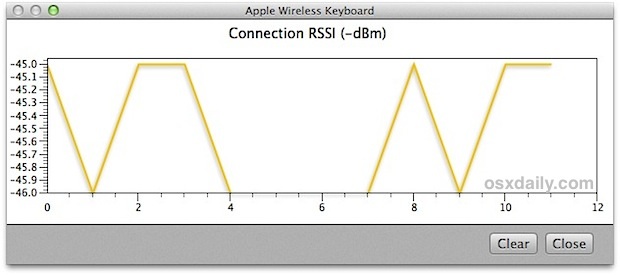How to Fix Randomly Disconnecting Bluetooth Keyboards and Devices

Bluetooth devices are usually extremely reliable, but every once in a while something can start acting up and either lose it’s connection with the Mac completely, or suddenly develop a flaky connection. With something like the Apple Wireless Keyboard, a Magic Trackpad, or a Magic Mouse, it’s fairly obvious when something is going wrong; clicks will stop registering, keys will get stuck typing a character, the device will randomly disconnect, or you’ll get stuck in an annoying “Connection Lost” to “Connected” loop that flashes the device logos on screen like this:

This can get stuck in a constant loop that reoccurs every few seconds or minutes, and when this happens something is up with the connection. Fortunately, it’s usually really quick to resolve, and if you find yourself battling connectivity issues with some wireless accessories, here are seven troubleshooting tips to get your Bluetooth device working as intended again with Mac OS X.
1: Check the Battery Level
The first thing you’ll want to do is check the battery level of Bluetooth devices. All Apple branded Bluetooth hardware like the Apple Wireless Keyboard, Magic Mouse, and Magic Trackpad, will relay the precise battery level through the Bluetooth menu. Some third party devices will show this information as well. All you need to do is pull down the Bluetooth menu item, go down to the device name, and look next to “Battery Level” to see the remaining percentage:

Do note this is not entirely accurate with all batteries, and some devices seem to inaccurately report levels all the time. A good rule of thumb is that once the indicator goes below 50%, or if you’re experiencing frequent random disconnections, it is a good idea to swap out with a fresh set of full batteries. Because being without a keyboard or mouse is never fun, it’s best to have a second set of rechargeables ready to go nearby. Invest in good rechargeable batteries and you’ll never be without your wireless accessories for more than a few seconds as they get changed.
2: Change the Batteries
For most connection problems, the problem comes down to the battery life. Swapping out the batteries only takes a second and it’s often the easiest way to regain reliable bluetooth connectivity for keyboards and mice.

If you don’t have a set of good rechargeable batteries yet, they are well worth the investment and they end up paying for themselves within about 3-4 recharges. Buy them once and you’ll basically never have to buy batteries again, click here for a decent set of AA that is under $20, I use the same set on my Apple Wireless Keyboard and they last for months per single charge.
3: Cycle Bluetooth OFF & ON
The simplest way to power cycle Bluetooth is to pull down the menu, select “Turn Bluetooth Off”, then let it sit for a moment to take effect before going back to the same menu and choosing “Turn Bluetooth On”.

This will cause the keyboard/mouse/device to automatically resync with the Mac.
4: Turn the Device / Keyboard OFF & ON
Simply turning the Bluetooth device off and on again is often enough to kick it back into gear. For an Apple Wireless Keyboard you can power-cycle it by pressing and holding the power button until the little green light turns off, then press again to turn it back on. The device will automatically connect and you should be good to go.
Note: this process happens automatically if you change the devices batteries and it does not need to be repeated in that case.
5: Delete the Device Profile & Re-Add
Open System Preferences, go to Bluetooth, and delete the device profile from the preferences list by selecting it, then clicking the little “-” icon in the bottom. Now re-add by clicking the “+” icon, go through the extremely simple setup process, and re-sync the device. This works in the unusual event the preferences or plist has become corrupted.
6: Check Signal Strength
You can quickly reveal any connected Bluetooth devices signal strength through a hidden strength indicator that is accessible through Bluetooth settings. Open System Preferences > Bluetooth, then hold down the “Option” key to show the indicator. More bars is obviously a stronger connection, and if you only have one or two bars visible here then you either have an issue with signal power (and thus, battery), or general interference from other devices.
7: Check for General Interference
Check for obvious interference from things like microwaves (yes, the kitchen variety) or tons of bluetooth devices next to each other. If you have no obvious interference nearby, go ahead and monitor the connection strength of the Bluetooth device by using the built-in tool described hereto determine the signal power, and then make adjustments to the environment and device locations accordingly.

If the signal is extremely weak or there is high interference, that could be an issue with something in the environment blocking effective transmission, like large metal walls, fireplaces, appliances, and with weak signals, it can even be a symptom of bad batteries. Thus, we recommend this last, because for 98% of user cases with Bluetooth connectivity issues, the problem is often resolved simply by swapping in a new battery or two.
What about iOS devices?
The ability to troubleshoot bluetooth devices connected to iOS is more difficult because there are not the same verbose tools to detect things like interference, but because most problems come down to batteries, simply swap them out, and go through the connection process again to resync the device back to iOS. In nearly all cases, the BT device or external keyboard will then work just fine, whether it’s connected to an iPhone or iPad.
